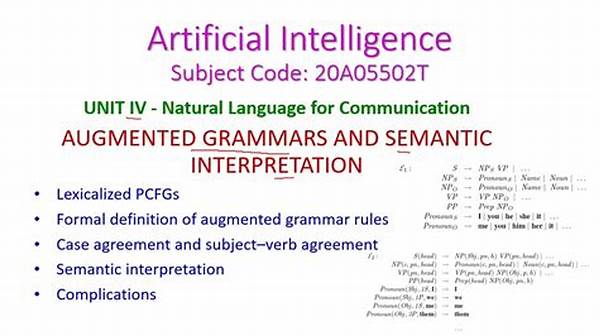Semantic Interpretation in AI
In the vast world of Artificial Intelligence, “semantic interpretation” represents a game-changing capability that breathes “life” into the interaction between humans and machines. Understanding the meaning behind the language humans use is crucial for AI systems to accurately process and react to various inputs. Think about it: wouldn’t you be amused if an AI misunderstood “spill the beans” as a grocery list item rather than a request to share a secret? While this might be humorous, in serious applications like healthcare or customer support, accurate semantic interpretation in AI can make the difference between life-saving information and a costly misunderstanding.
The Quest for Meaning
Imagine conversing with a machine that understands and empathizes with you, like your favorite barista remembering your usual order or offering a comforting word on a gloomy day. AI’s semantic interpretation capabilities strive to achieve this level of connection by dissecting the underlying meanings and nuances within human speech and text. It’s like building a “mind reader” of sorts, only it’s tech-savvy and much faster!
The process involves analyzing linguistic components such as syntax, context, and semantics, transforming raw data into rich, meaningful insights. With the power of semantic interpretation in AI, computers can understand jokes, gauge sentiment, and even detect sarcasm. For marketers, this means tailoring promotions to engage customers genuinely. For everyday users, it makes AI not just smart, but relatable — as if your Amazon Alexa received a personality update!
Bridging the Communication Gap
From quirky chatbots that crack jokes just like your funny uncle to sophisticated conversational agents offering round-the-clock customer support, semantic interpretation in AI plays a critical role in enhancing communication. It’s like having a multilingual genius transcending language barriers, ensuring that no detail gets lost in translation. Clearly, the potential applications are endless and exciting.
Whether it’s to fuel innovation in tech companies, improve customer service, or unleash a wave of creative marketing strategies, the embrace of semantic interpretation in AI is spreading like wildfire. Businesses are already leveraging these strengths to craft engaging, personalized experiences that pull at the heartstrings of their audience. It’s no longer just about what the machine can do, but how it makes you feel.
Applications of Semantic Interpretation in AI
As this innovation continues to evolve, businesses must embrace its potential. Suppose your business is not engaging in semantic interpretation in AI, the next move might just be calling [Your Company Name] for cutting-edge solutions that put you at the forefront of this technology trend. Remember, every whisper of potential must be decoded effectively, and that, dear reader, is where tomorrow’s magic lies.
—
Understanding Semantic Interpretation in AI
How Semantic Interpretation Works
The magic behind Artificial Intelligence’s ability to comprehend and react like humans lies in semantic interpretation. It’s akin to giving robots a “language brain” where they grasp not just the words but the meaning, intention, and emotion involved. Picture this: AI that understands not just “what you say” but “what you really mean.” This breakthrough enables systems to interact seamlessly with human contexts, making AI not just reactive but proactive.
The Importance of Context
Context is everything! When Siri suggests a song to suit your mood, it’s employing semantic interpretation to align your environment, tone, and preferences. It’s like having a tech-savvy friend choosing to play “Eye of the Tiger” when you hit the gym rather than during your yoga session — context is key! Semantic interpretation transforms mere data parsing into understanding, ensuring dynamic, relevant interactions tailored to individual needs.
Real-World Applications
Semantic interpretation in AI finds its footing in a myriad of real-world applications. In customer service, AI assistants become more adept at handling inquiries with empathy and relevance. In healthcare, AI’s nuanced understanding helps bridge patient-provider communication gaps, ensuring critical health directives are interpreted accurately. Furthermore, education platforms harness semantic understanding to customize learning materials, optimizing student engagement and retention.
Advancements and Opportunities
With technological strides, the potential of semantic interpretation grows exponentially, offering opportunities for innovation across multiple industries. Businesses can harness AI to streamline processes, enhance customer experience, and even predict market trends. By tapping into this cutting-edge technology, organizations are not just partaking in a trend but are setting the stage for future breakthroughs that redefine service standards.
Challenges and the Future
However, perfecting semantic interpretation in AI isn’t without its challenges. Translating the intricacies of human emotion and culture into machine-readable language is daunting. Yet, with ongoing research and development, these hurdles are gradually being overcome. The future promises enhanced capabilities with AI that is not just smart but wise, forming partnerships with humans that are both productive and enriching.
Key Features of Semantic Interpretation in AI
Addressing the Semantic Challenge
The journey of semantic interpretation in AI is like riding a rollercoaster of possibilities. Imagine waking each day to more intuitive technology that goes beyond mere tasks to anticipating needs and transforming how we perceive AI. It’s about making machines genuinely “understand” us — a task that demands relentless curiosity and innovation.
Such semantically intelligent AI holds the power to revolutionize communication, providing cutting-edge solutions that enhance personalized experiences and drive growth. For developers and entrepreneurs, the goal is clear: invest in the art of semantic interpretation and reimagine what AI can do. It’s a chance to redefine technology’s role as a partner rather than a tool — a partner capable of a meaningful dialogue grounded in context, empathy, and insight.

